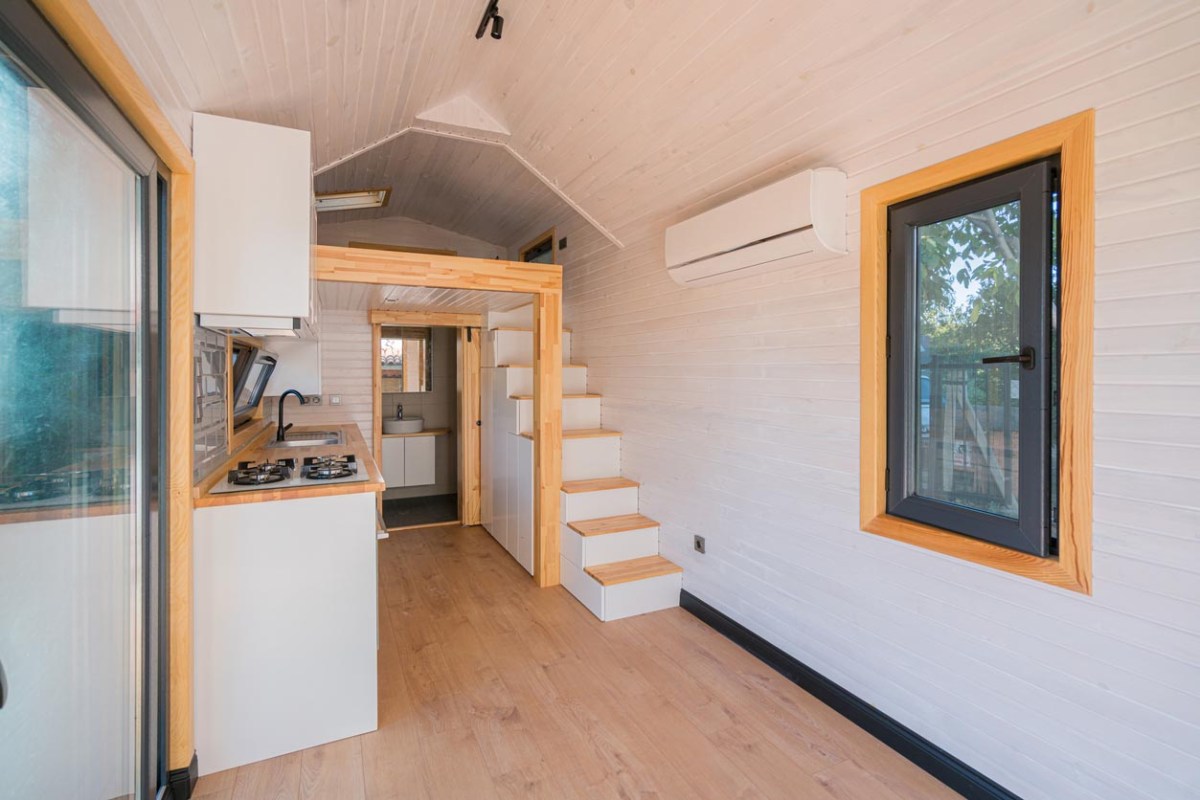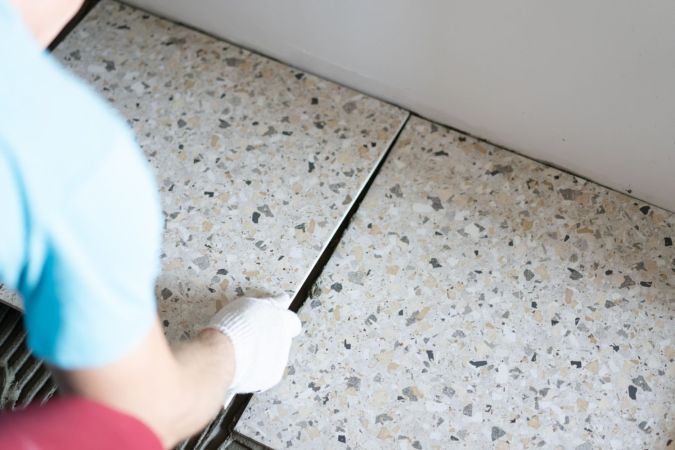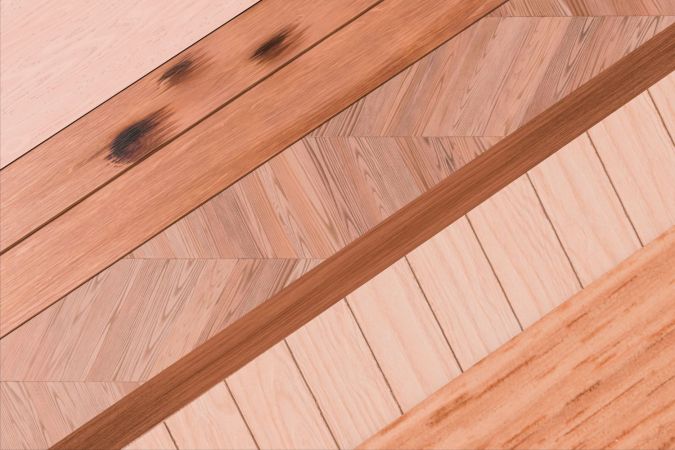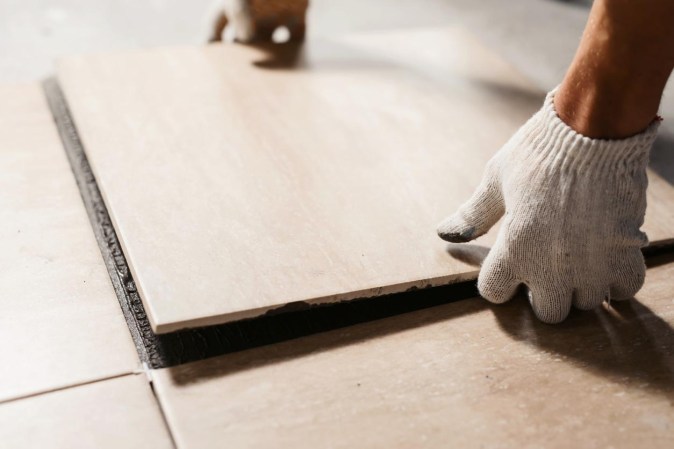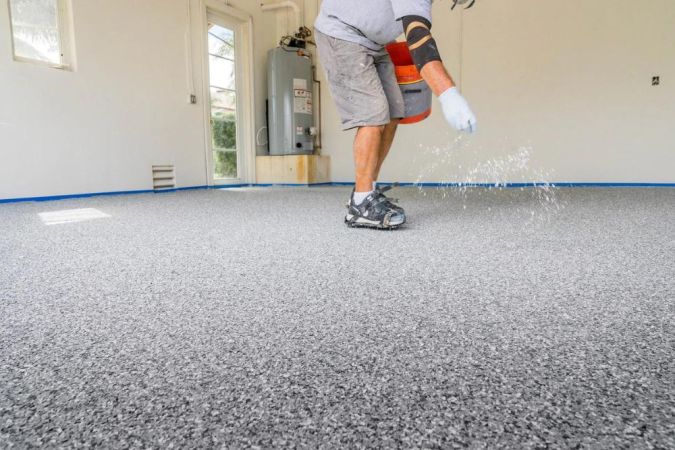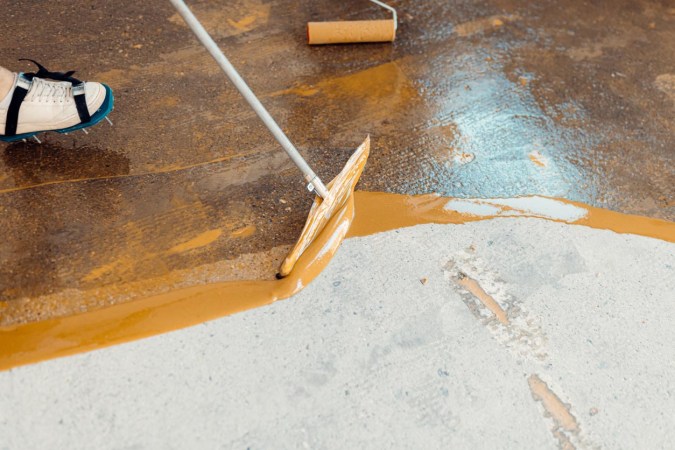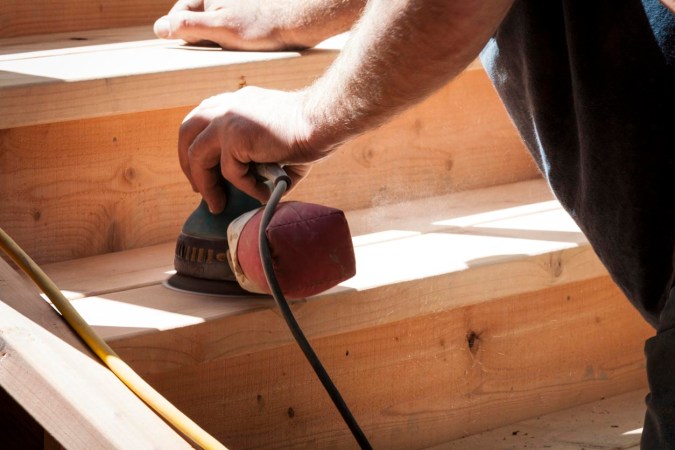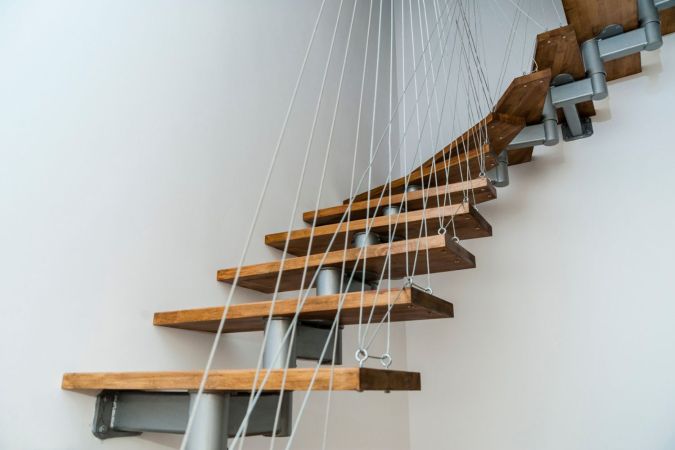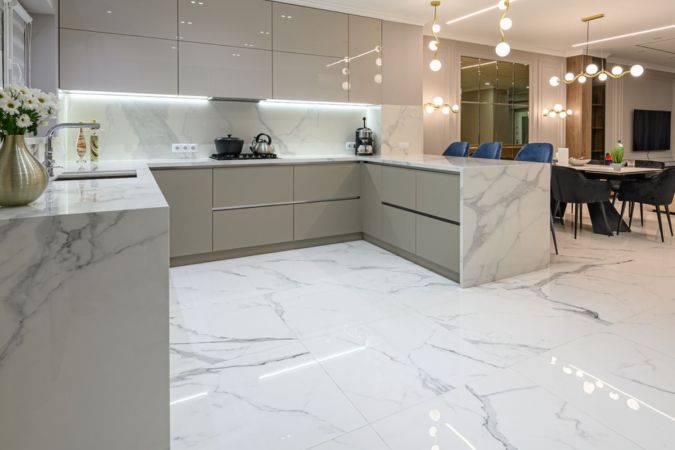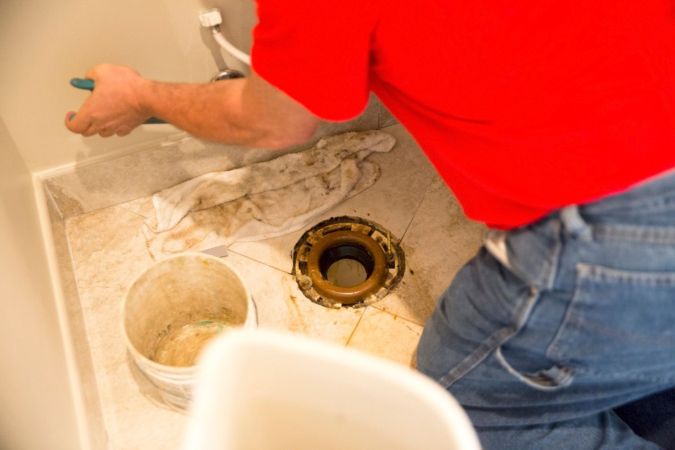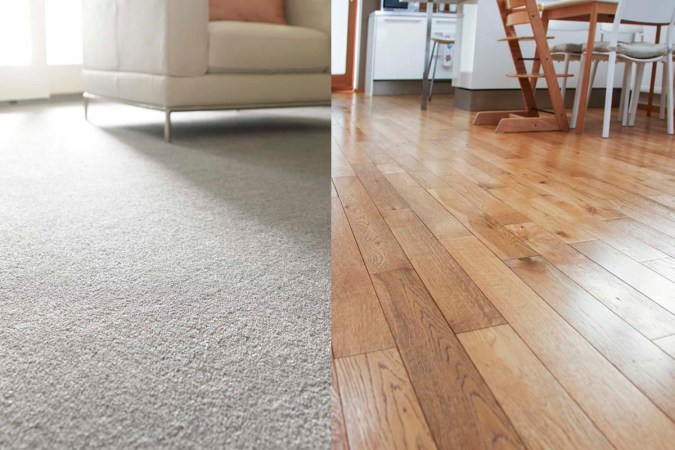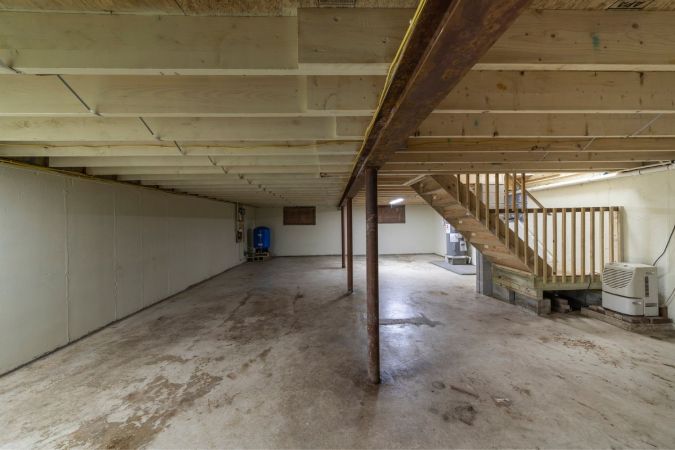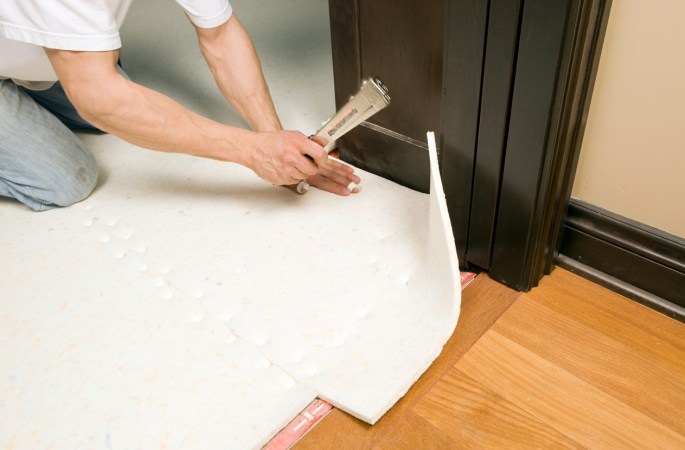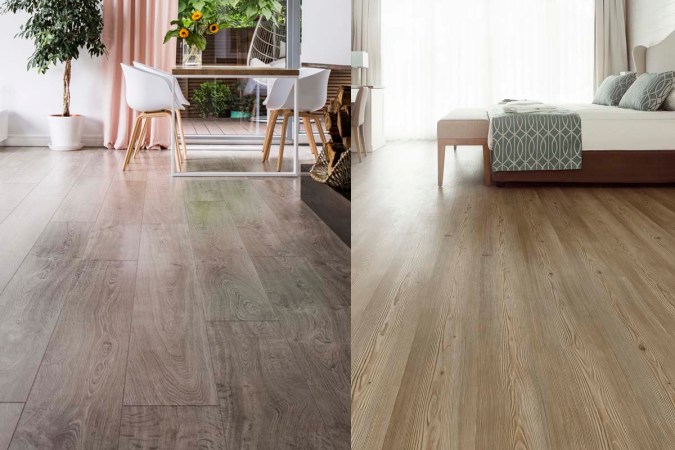We may earn revenue from the products available on this page and participate in affiliate programs. Learn More ›
Highlights
- Most homeowners spend between $300 and $5,000 on mobile home floor repair cost, though the national average is around $2,650.
- The cost to repair a mobile home floor is largely dependent on the size of the floor, the extent of damage, the material, labor costs, and whether subfloor or joist repairs are also needed.
- When a mobile home floor shows signs of warping, cracking, sagging, or dry rot, homeowners will want to speak with a contractor about repairing or replacing the floor.
- Minor repairs and updates can be done by many homeowners, but significant floor repairs or replacement need the expertise of a professional flooring specialist. This is especially true if an inspection shows damage to the subfloor or joists, which can compromise the integrity of the floor.
Mobile home floor damage can result from a sudden incident, such as a burst pipe, or from sustained moisture over time, such as a slow leak from a toilet. Either way, repairing the mobile home floor as quickly as possible can help avoid other flooring issues and ensure the floor is safe and stable. Mobile home floor repair costs between $300 and $5,000, according to Angi, with a national average cost of $2,650.
In some cases, the flooring, subflooring, or joists can be repaired, which will keep costs at the lower end of the range. In other cases, it can cost much more if the damage is significant and the floors need to be replaced.
Factors in Calculating Mobile Home Floor Repair Cost
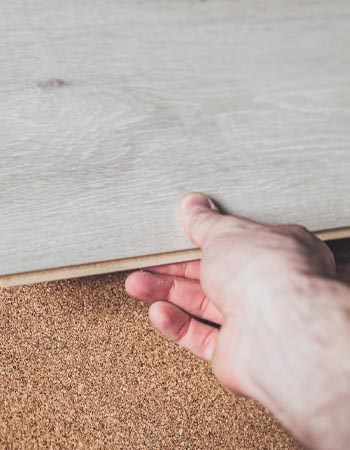
Despite the basic foundational differences between mobile homes and traditional homes, mobile home flooring is constructed in about the same manner as flooring in traditional homes: the joists support the subfloor and the flooring lays on top of the subfloor. Damage to mobile home floors can happen at any layer, and the cost to repair them largely depends on the size of the area, the floor material, and the cost of labor.
These repairs need to be handled quickly for safety reasons, yet funds are not always easily accessible. In that case, homeowners may want to consider getting one of the best home equity loans (such as one from U.S. Bank or Flagstar Bank) to cover the cost of repairs.
Floor Size
Typically, flooring projects are priced per square foot, which makes the total cost dependent on the size of the area that needs repairing. Mobile home flooring repairs cost between $2 and $30 per square foot. In some cases, the flooring repairs are confined to a small area, and these will cost less than repairing the entire floor. However, if all of the floors need to be repaired, the size of the mobile home will factor into the total repair cost.
Floor Material
The floor material can impact the overall cost of the repairs since some materials are more difficult to install than others and will require more labor time. Carpet is the most affordable flooring, which costs $130 on the low end for repairs and starts at $800 for replacement. The most expensive type of material is wood, starting at $450 for repair and $2,500 for replacement. Vinyl or linoleum can cost a minimum of $200 to repair, while tile repair starts at $275 and laminate ranges between $350 and $1,600 for repairs.
Labor
Most homeowners don’t know how to repair a mobile home floor, which is why they’ll need to factor in labor costs. Typically, labor for floor installation costs between $25 and $40 per hour. Flooring contractors can help determine what repairs are needed and recommend materials to complete the repairs. Flooring contractors in areas with a high cost of living can charge as much as $120 per hour for installation, so getting quotes is essential for homeowners working within a budget.
Additional Costs and Considerations
In some cases, damaged mobile home floors can be repaired by removing and replacing the damaged section, removing stains on the carpet, and replacing or repairing sections of the subfloor floor or joists. Other times, the floor is so damaged that full replacement is best, leading to a higher price in the end.
Floor Repair vs. Replacement
If the mobile home floor damage is minimal, savvy homeowners may be able to use a DIY kit to fill scratches and dents in certain types of floors. They may even have a small patch of carpet that they can replace on their own. This significantly reduces the cost of mobile home floor repair, but for damage that affects the subfloor or covers a large area, homeowners will want to discuss the project with mobile home contractors before deciding how to proceed with the project.
The average cost to repair a mobile home floor falls between $130 and $1,850 depending on the type of flooring, the extent of the damage, and the materials needed. If the floor shows significant damage, it may be best to do a full floor replacement, which can cost between $800 and $6,800 depending on the size of the mobile home and the floor-covering material.
Subfloor Repair
Owners of mobile homes may wonder what a subfloor is and who to hire to replace a subfloor. Different subfloor types exist for mobile homes, but they are usually made of plywood or oriented strand board (OSB). Secured to the floor joists for support, subfloors provide the surface for the floor covering. If the subfloor is only slightly damaged, the contractor can cut out the damaged subfloor material and replace it.
But full replacement will be recommended if the contractor spots significant damage to the majority of the subfloor, especially if the homeowner has noticed the floors squeaking or sagging. Replacement is also typically recommended if particleboard was used for the subfloor since that material is prone to softening faster than most materials. New flooring may also require an underlayment if the visible flooring can’t adhere to the subfloor (for instance, a concrete subfloor).
Floors often also have a layer in between the subfloor and floor covering called the underlayment. Homeowners may have to replace both the subfloor and underlayment, but in some cases the subfloor may be intact while the underlayment needs to be replaced. Subfloor installation will increase the total cost of floor repair. The cost to replace the subfloor in a mobile home is between $1,800 and $3,000, but if the homeowner is only repairing a damaged section, that cost could come in between $500 and $700.
Sometimes, the floor and other parts of the mobile home are too damaged from neglect or natural disasters. In such cases, purchasing a new home is the better option, and homeowners can look at using one of the best mobile home loans to finance their purchase.
| Type of Subfloor Material | Average Replacement Cost (Materials and Labor) |
| Oriented strand board (OSB) | $1.40 to $3 per square foot |
| Plywood | $1.50 to $3.50 per square foot |
| Underlayment | $0.50 to $1 |
Floor Joist Repair
The floor joists are the horizontal beams that run under the subfloor to support the subfloor, underlayment, and floor covering. If the floor joists are damaged, it can create a dangerous situation for the homeowner. In some cases,repairing the floor joists is a matter of reinforcing them, which costs between $100 and $300 per joist. Replacing all of the floor joists costs between $5,000 and $20,000, or between $1,000 and $10,000 if repairs are confined to a few damaged joists.
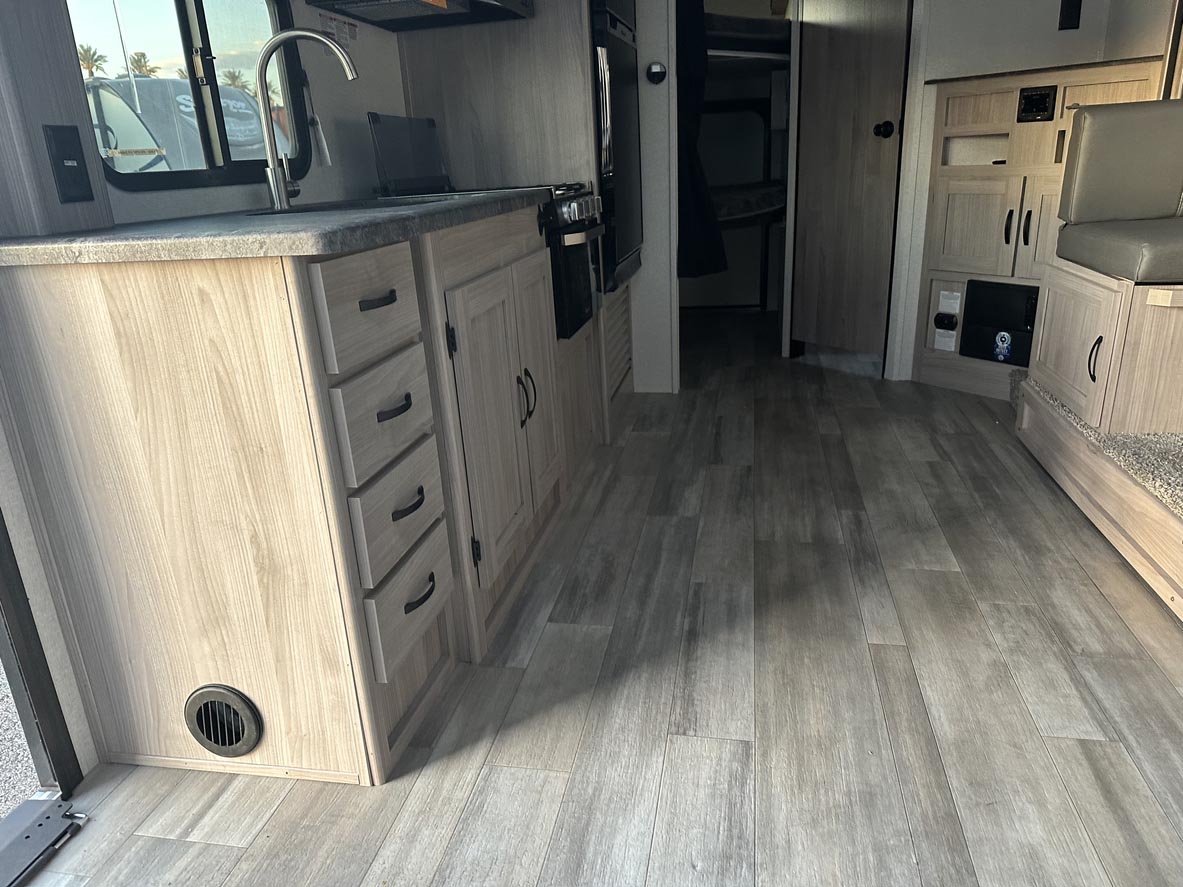
Mobile Home Floor Repair Cost by Type of Material
The type of floor-covering material will impact the overall mobile home floor repair cost. Some materials, such as carpet and laminate flooring, cost much less than other materials, such as hardwood or tile flooring. There are pros and cons when homeowners are comparing laminate vs. vinyl flooring costs, and it’s helpful to consider these before choosing a replacement material. Talking with a mobile home floor repair contractor will help homeowners get a good idea of how much each type costs.
| Type of Floor Material | Average Repair Cost (Materials and Labor) | Average Replacement Cost (Materials and Labor) |
| Carpet | $130 to $300 | $800 to $2,800 |
| Laminate | $350 to $1,600 | $1,500 to $4,600 |
| Tile | $275 to $670 | $900 to $3,000 |
| Vinyl or linoleum | $200 to $1,850 | $950 to $3,650 |
| Wood | $450 to $1,500 | $2,500 to $6,800 |
Carpet
Most carpet repairs involve patching rips and worn areas or deep cleaning stains. Professional carpet cleaning costs an average of $180 and is a great way to freshen up dirty carpets. If the carpet is burned or water damaged, repairs may not be possible, so homeowners can expect to pay for full replacement, which can run between $800 and $2,800.
Laminate
A popular option for homeowners who want an affordable floor that can mimic wood, stone, or tile is laminate. This type of flooring is also less expensive to repair, especially when it’s the tongue-and-groove style that snaps together. Laminate floors can often be repaired by removing damaged planks and replacing them in just a couple of hours. Repairs typically cost between $350 and $1,600, whereas laminate floor replacement costs between $1,500 and $4,600.
Tile
A more expensive option than carpet or laminate is tile flooring. However, this flooring is heavy and will require an underlayment too. Ceramic or porcelain tiles are difficult to repair, and replacement can be tricky, so it costs between $275 and $670 to repair but as much as $3,000 to replace.
Vinyl or Linoleum
Other popular and low-cost flooring options are vinyl or linoleum, which come in a number of styles and looks. Linoleum and vinyl flooring can often be repaired by removing and replacing the damaged sections. Repairs typically cost between $200 and $1,850, while replacement runs between $950 and $3,650.
Wood
For the most natural look, many homeowners opt for wood floors, which are a more expensive material. Sometimes wood floors can be repaired fairly easily depending on the kind of damage that occurred. Small scratches or dents on wood floors can be fixed with a DIY repair kit for about $20, but if serious damage or dry rot has happened, then repairs may cost between $450 and $1,500. Full replacement of mobile home wood floors can cost between $2,500 and $6,800, but homeowners can call one of the best hardwood flooring installation companies for an accurate estimate in their area.
Do I need mobile home floor repair?
While some mobile home floor issues can remain hidden, it’s likely they’ll reveal themselves in some way. Issues such as warping, gapping, cracking, cupping, or sinking can alert homeowners of floor issues that need to be addressed. Other concerns, such as dry rot or mold, may take longer to notice, especially if they’re affecting the hidden floor joists.
Once homeowners notice an issue, it’s important to schedule an inspection by a mobile home floor repair contractor so they can make a plan for repairs or replacement. If replacement is expected, homeowners can reach out to the best flooring companies that do floors for mobile homes for quotes.
Dry Rot or Mold
Dry rot is a result of a fungus that causes wood to decay and become soft and spongy. It’s often the result of poor ventilation, and if it develops in mobile home floor joists, it can result in a sagging floor. In the worst-case scenario, a floor joist will become so weak that it collapses under the weight of furniture or people.
Mold grows in areas with excessive or persistent moisture due to high humidity or constant leaks. Mold can infest the floor joists and flooring, creating a dangerous situation for people who are sensitive to mold or mold spores. It can also damage the floor joists, weakening them over time. If residents are having unexplained symptoms such as red eyes, confusion, brain fog, runny noses, or wheezing, then mold may be growing in the home. Mold remediation costs an average of $2,254 and will be an additional cost on top of floor replacement if the contamination is severe.
Warping
If the flooring begins to warp or is uneven, this may be a sign that it needs to be replaced. A flooring company can identify whether the flooring material is warping as a result of moisture or water damage or if the underlay, subfloors, or joists are causing the warping in the flooring. No matter the cause, warping is cause for an inspection as it indicates the flooring is not structurally sound anymore.
Cupping or Sinking
Flooring that’s beginning to cup on the edges or sink in the middle is a sign that the floors are damaged. If the damage is confined to the flooring material, homeowners may be able to repair or replace a small section where water damage occurred. But if the problem stems from the subfloor or floor joists, it may be a more extensive project.
Gapping or Cracking
While certain flooring materials, such as wood, slightly expand and contract with changing environmental conditions and moisture levels, consistently visible gaps may warrant a proper inspection. A flooring contractor can assess what the gap indicates about the state of the floor or even the entire house. Gapping or cracking flooring can be a sign that the subfloor or floor joists are shifting. This could be a result of the house settling naturally or unnaturally. Gapping or cracking could also be a sign of excess moisture under the floor.
Loose Flooring Sections
If sections of the flooring have come loose over time, it may be time to repair or replace those sections. With some types of flooring, simple repairs are relatively easy. Wood planks or sections of vinyl can be removed and replaced, but more work will be required to remove ceramic or porcelain tiles and the grout that keeps them in place.
Squeaky Floorboards
Squeaky floorboards can be a sign that there is an issue with the subfloor or joists, if it’s not simply a loose board that wasn’t secured properly. Warped joists or subfloors can cause the floorboards to creak and squeak, which can annoy the occupants of the home. Annoyance or not, squeaky floorboards are best addressed before a bigger problem occurs with the joists beneath.
Discoloration
Flooring discoloration could be the result of water damage. It’s often the first clue that the flooring needs to be repaired or replaced. If the discoloration is merely stains on a carpet, homeowners may be able to hire a carpet cleaning company to remove the stains and restore the carpet to its earlier appearance.
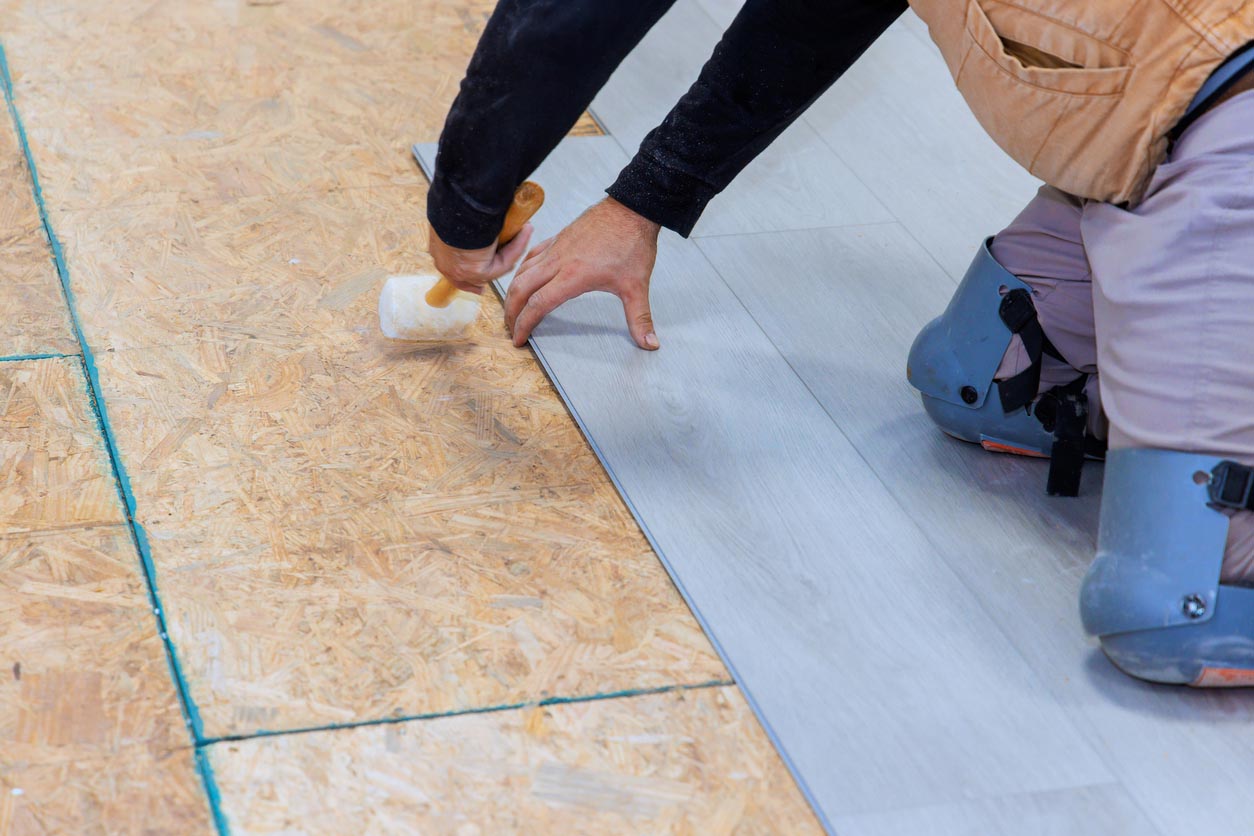
DIY vs. Hiring a Professional for Mobile Home Floor Repair
Homeowners may be able to take on several basic flooring repairs in their mobile homes. Some repairs, such as cleaning the carpet or repairing light scratches in the wood, are DIY-friendly projects. Putting in new subfloors or an entire tile floor is only a DIY job if homeowners have plenty of flooring experience behind them and the right tools and skills to remove a section and replace it. Since that’s not the case for many homeowners, they typically opt to hire a contractor who knows where to find hidden damage and how to repair it—no matter the type of material.
In addition, more complex projects such as mobile home leveling (a process that helps prevent the home from shifting on an unstable foundation) or replacing floor joists and subfloors are best left to the professionals. A professional will be able to assess the extent of the damage and make recommendations for the best course of action. They can help the homeowner decide between repairs and replacement and provide evidence for the better choice. Choosing a contractor who specializes in a particular type of flooring or mobile home flooring can help a homeowner ensure the job is done right the first time.
How to Save Money on Mobile Home Floor Repair Cost
The cost of repairing floors can add up quickly, so finding ways to save money on the total cost of the project can ease the stress on the homeowner’s wallet. Here are some tips to save money on mobile home floor repair costs.
- Minimize repairs if possible. When the damage isn’t severe, homeowners can request to have repairs only on the damaged area and keep the rest of the floor intact.
- DIY damage removal. For homeowners who are physically able and have the right tools, it’s possible they may be able to remove damaged sections of flooring on their own and reduce labor costs.
- Obtain multiple quotes. Getting quotes from multiple mobile home flooring contractors to compare costs and services helps homeowners find the right price and value.
- Opt for a home warranty. Getting a policy from one of best home warranties for mobile homes can help them save money on repairs and even replacement in the long run. Top companies include AFC Home Club and American Home Shield.
- Speak to your insurance representative. Owners of mobile homes may have insurance coverage from one of the best mobile home insurance companies, so they’ll want to speak to their representative to find out if repairs are covered if the damage occurred due to a storm or other covered event.
- Call your mobile home builder. If the mobile home is a new build, then homeowners are advised to call their builder to ask about repairs to the new floors. If it’s not a new construction, homeowners can still call any of the best mobile home manufacturers to see if they recommend a specific flooring contractor to do repairs.
Questions to Ask About Mobile Home Floor Repair
Anytime a contractor works on a home, it’s in the homeowner’s best interest to understand the process, how long it will take, what it will cost, and what’s expected of them. Asking these questions will help ensure homeowners have the information they need and can adequately prepare for the project.
- Are you licensed, bonded, and insured?
- How long have you been in business?
- Do you offer a free on-site inspection?
- What caused the damage, and how extensive is it?
- What kinds of flooring materials are you used to working with?
- Will you complete the repair or subcontract?
- Is subfloor repair or replacement required?
- Is joist repair or replacement required?
- Can you fix the underlying issue, or do I need to contact another contractor (such as a plumber)?
- Is there other damage that needs to be assessed such as electrical wiring?
- Do you provide a written quote? How accurate do your quotes tend to be?
- How long will the project take?
- What should I do to prepare the area?
- Do I need to be present during the work?
- Do you offer any warranties or guarantees on your work?
FAQs
Mobile home floor repair can be confined to a quick fix in one area or the floors may require extensive work that includes repairing joists, repairing the subfloor, fixing the floor covering, or all of the above. Leaving the issue unattended can eventually put the home’s occupants at risk of a floor collapsing, so homeowners are encouraged to speak with a professional as soon as possible. For additional information about mobile home floor repair costs, here are the answers to several frequently asked questions.
Q. Does homeowners insurance cover subfloor replacement?
Homeowners insurance coverage for replacing a subfloor depends on the individual policy and what the policy considers a “covered” event. Water damage may be covered if it’s the result of an accidental incident, such as a burst pipe. Slow pipe leaks or a flood, however, are not likely to be covered.
Q. How long does it take to replace a subfloor?
Replacing subfloors in a small area can take about 3 to 5 hours and consists of cutting out the damaged area, replacing the subfloor material, and then replacing the floor-covering material. An entire subfloor can be replaced in 3 to 5 days depending on the size of the home and the number of workers.
Q. Can you put a new subfloor over an old subfloor?
If the old subfloor is in good, stable condition (meaning it’s not warped, cupped, bumpy, or rotten), then a contractor can install the new subfloor over the old subfloor. If the old subfloor is damaged, a contractor will remove it and install a new subfloor in its place. This ensures a stable surface on which to install the floor-covering material.
Q. How long does a subfloor last?
A subfloor that’s well protected from moisture and damage won’t need replacing as long as the house stands. But if there are extensive or continuous moisture issues, then the lifespan can reduce to 20 or 30 years—or less depending on the severity. If there is an accident, such as a natural flood or a leak from broken pipes, then the subfloor should be assessed to see how much damage there is and if it needs to be replaced.
Q. What is the best material to use for a subfloor?
Subfloors are typically plywood, but they can also be made from OSB or particleboard. Plywood is durable but can be more expensive than the other materials. OSB, or oriented strand board, isn’t as durable as plywood, but it’s less expensive. Particleboard is the least expensive option, but it’s also the least durable and the most likely to require replacement if any flooring issues arise. The best material depends on the budget and how long the homeowner expects it to last.
Sources: Angi, HomeGuide

